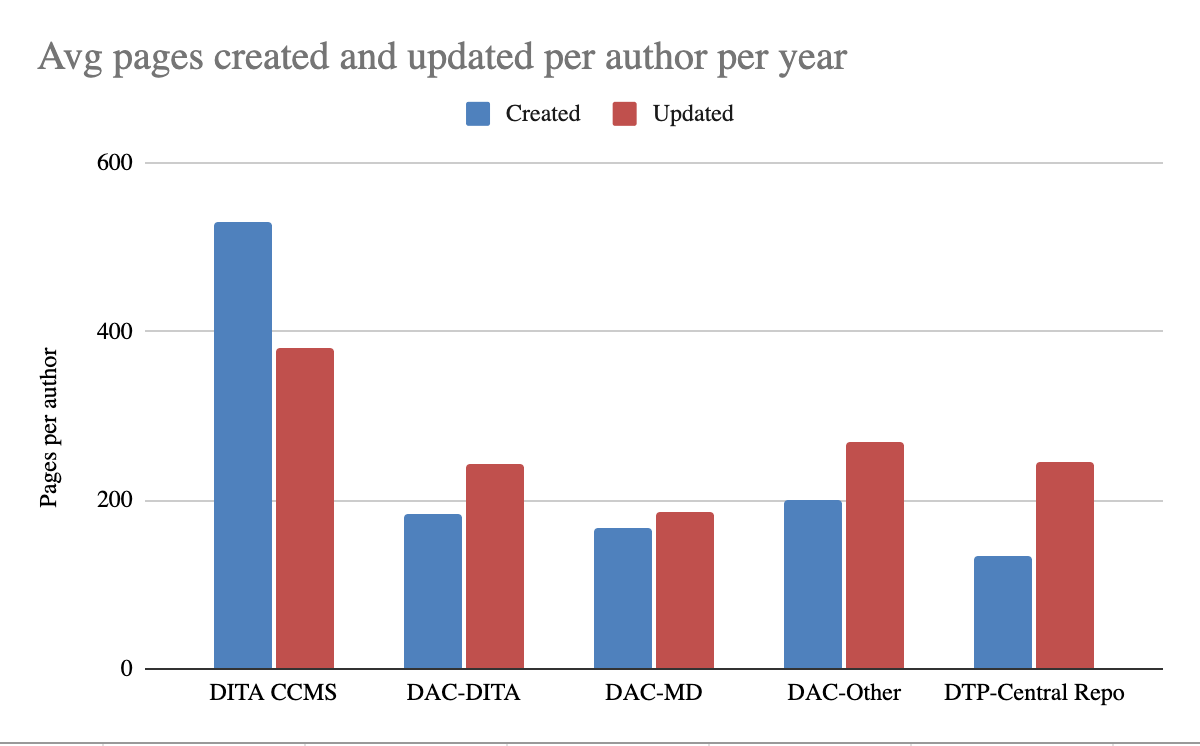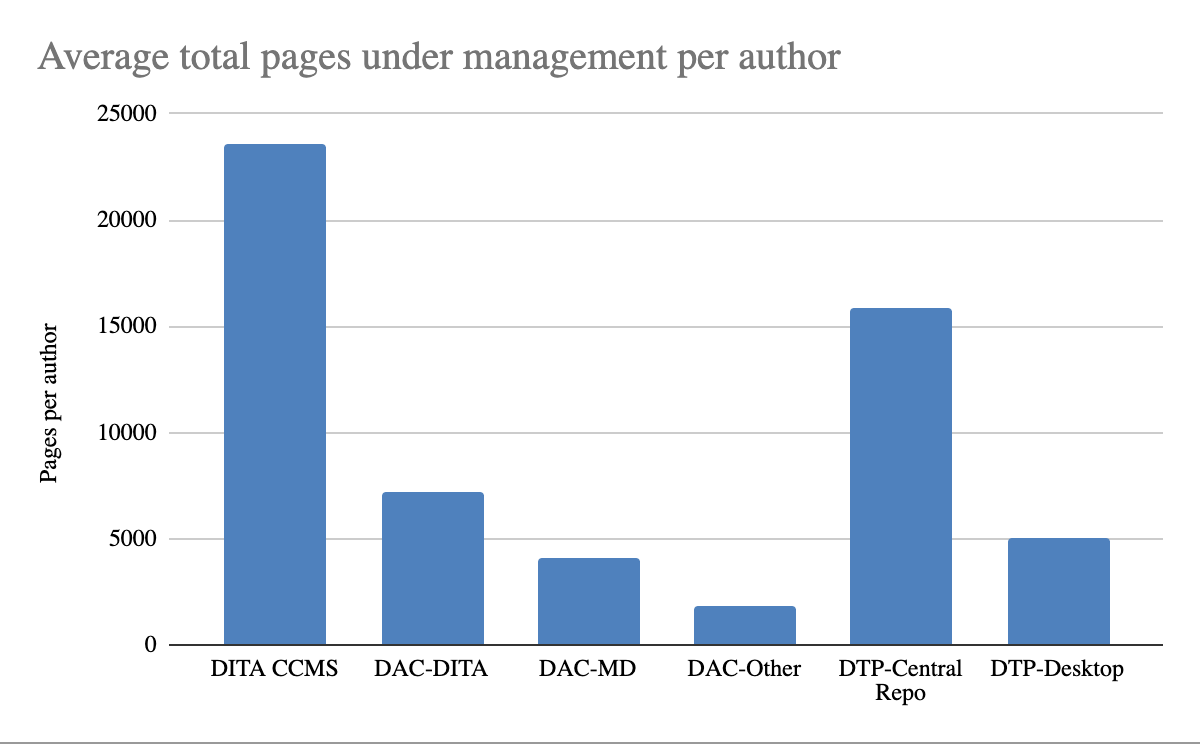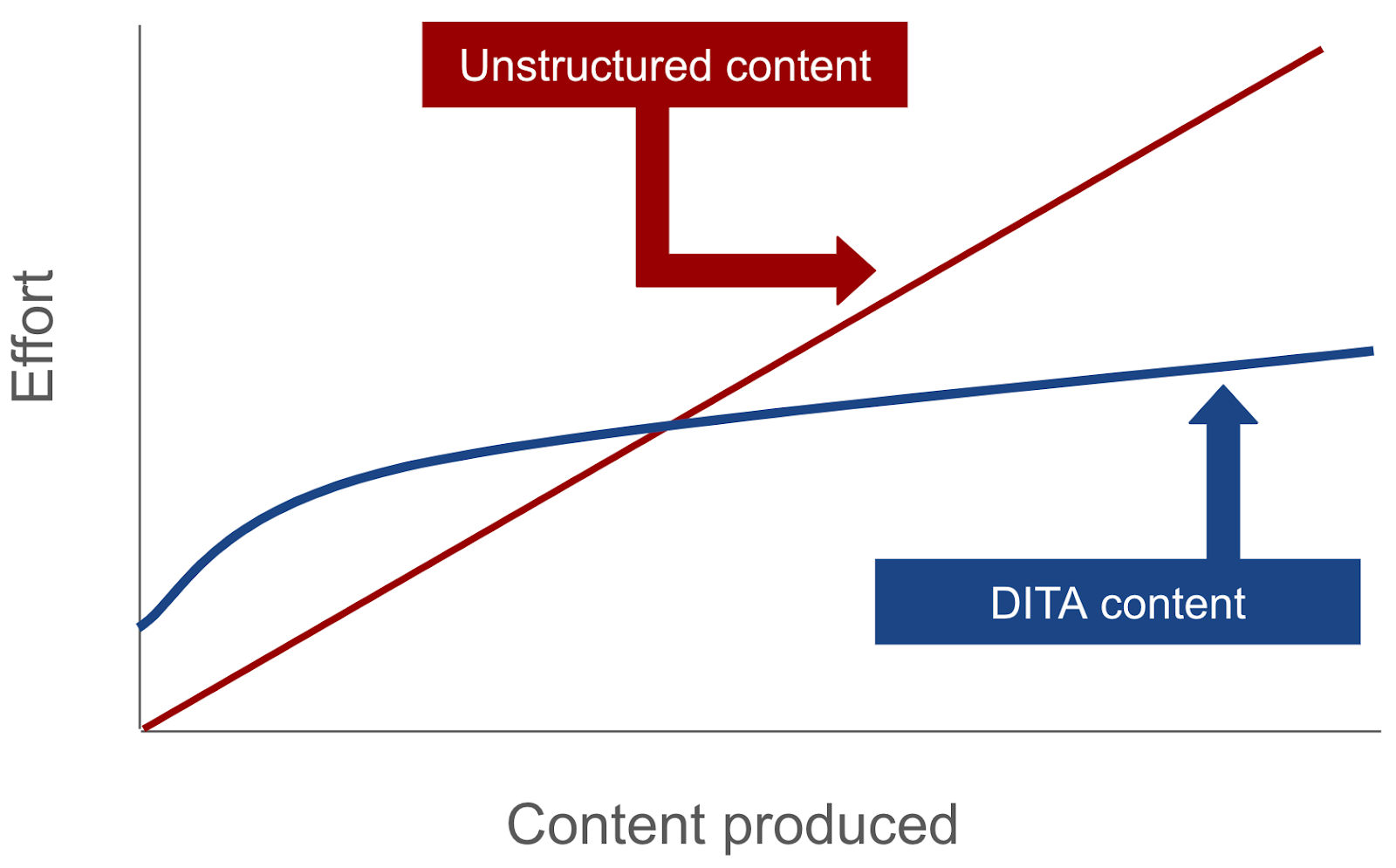Why DITA?
It powers faster content, at scale.
DITA is faster for a number of reasons, which we’ll discuss below. But before we get into those details, let’s explore why being faster in technical content production matters to a business.
Faster matters because content costs less than support tickets
Self-service is the least expensive and most preferred way for a customer to interact with a company. Not all interactions can be self-service, but for the ones that can, it’s the best. When it comes to onboarding, troubleshooting, and product support, the speed limiter is generally content. If customers can’t quickly find answers or the information they’re looking for in your content library, they contact support; it’s that simple.
Depending on your company’s situation, solving a customer’s problem with content rather than a support ticket can be 1000s or 10,000s times less expensive. It’s massively more efficient.
The simple truth is that your support costs are a function of your human-required issues + not covered self-service issues. The lowest hanging fruit is producing the content to cover all self-service issues, and in order to do this, your team needs to be faster at content production, because covering all self-service is often a lot of content.
Faster matters because prospects check the docs
Prospects check documentation for two primary reasons: vibe and validation.
We all know what a robust, professional documentation experience looks and feels like. It’s like walking into a hotel lobby that is well staffed, clean, organized, and well maintained. This is the vibe. It translates to trust. When prospects see that an organization takes their product documentation seriously, it builds a feeling that the organization takes their success seriously.
We all know that marketing websites are there to sell stuff, they’re there for the company. Yes, they’re helpful to us, but the primary reason a company builds a website is to generate revenue, it’s for them.
Documentation sites are the opposite. They exist exclusively to help the customer. Yes, they also help the company reduce costs, but the primary reason for the content is helping customers.
This intrinsic truth is something everyone feels. When you see a company with an extremely expensive marketing site, but a minimal or forgotten documentation experience, it shows their priorities. And, of course, the inverse is also true, and perhaps more powerful. A great documentation site builds a prospect’s confidence that they have a solid and robust place to turn when they have an issue or want more from the product they purchased.
Faster matters because building this trust creating experience requires a team to produce a lot of high-quality content on a continuous basis.
How much faster does DITA make a content team?
Our data points to between 2 and 3 times faster. We’ve seen this trend throughout our experience with customers and also across several surveys. Here’s the data from our latest survey on this topic.
Starting with average pages created and updated per year per author, DITA in a CCMS (not necessarily Heretto) is roughly twice the volume of the other common options.

No surprise that…

Will DITA make my team faster?
The key question. The answer is, of course, it depends. On the graph below, the key thing to determine is where the intersection point is for your team.

There are ways to impact the position and slope of both lines, but fundamentally, the key factors are going to be reuse, personalization, and multichannel, which are the capabilities that make DITA faster. We go into the details of how these work below, but fundamentally these are the things that impact the slope of the DITA content line.
Teams that have no potential for reuse, no need for personalization, and only publish to one place, can sometimes still see enough benefit from the efficiency of automated publishing or reduction in translation costs.
How does DITA make content teams faster?
This is where we start getting into the technical details. If you want a tl;dr, it’s reuse.
Reuse comes in three different varieties:
- Source content reuse: One piece of content is used in multiple deliverables
- Personalization: One piece of content used, and altered, for different consumers
- Multichannel publishing: One piece of content used in different experiences
Source content reuse is the type of reuse most people are thinking of and referring to when they say they need reuse, but personalization and multichannel publishing are every bit as powerful and compelling for many organizations. Taken together, these three capabilities are how teams efficiently and consistently reuse content for different purposes, people, situations, and channels. And this is the single greatest capability of DITA as a methodology for content.
There are other important reasons organizations choose DITA, which we’ll go into later, but reuse is truly the central pillar of value.
The core reason we chose to build Heretto around DITA and why technical content teams choose DITA to build their content on is efficiency. DITA is about 50% more efficient than other methodologies when implemented well. Additionally, it’s the only content standard that doesn’t have scalability limits. DITA isn’t the best choice for all types of content, or even the best choice for all technical content, but it is the best choice for teams with large content sets.
Let’s look more closely at the types of reuse.
Source content reuse
Source content reuse is often what people mean when simply referring to reuse. Reusing source content is the foundation of scalable reuse. It’s what gives teams double digit efficiency improvements through eliminating copy-paste workflows used to manage similar content across multiple documents.
The traditional way people reuse content across documents is simply to duplicate it. Often this means copying it from where it’s created and pasting it into the places it’s the same. When this is one to one between a source and end-use location, it’s often not painful enough to fix. But when copying smaller pieces between source files to account for shared content becomes required, the workflow can quickly become too expensive to do manually. There is also a governance aspect to this issue, when content is copied, its chain of custody becomes disconnected and it’s not possible to ensure the end consumer has exactly what they should.
With DITA, content is linked together rather than being copied. If I wanted to use this paragraph in another article, I would simply create a link to it and when that article was published, it would have this paragraph inserted at the position of this link. In DITA-speak, this link is called a conref, which is short for content reference. This linking to reuse content can be done at almost every level, from individual words up to entire documents.
Source reuse has downstream impacts as well. Governance, for example, is often a key driver and is enabled by a strong reuse simply because when content that is going to be used in many places is reviewed people apply more rigor and scrutiny. And while governance is its own aspect, a great deal of governance is simply ensuring that the right thing is presented to the end user and reuse is a critical capability in ensuring that result.
Personalization
When most people hear the word personalization, they think of a marketing email where your name gets put in or Amazon suggesting new products based on the ones you’ve previously bought, but that’s not at all what it is in documentation.
Personalization in documentation is a type of reuse, but another way to think of it is that personalization and reuse are two sides of the same coin. Personalization is what unlocks reusing similar pieces of content rather than only being able to reuse content that is exactly the same. The most common example of this is two products that are very similar but have different names. In this case, DITA allows you to make the name a variable that changes based on the product so that you can reuse all the content around it. This is personalization, you’re personalizing the content to the product that the person owns.
Personalization is also flagging (adding metadata) to content that only applies to some audiences. A step in an install procedure may only apply to the version of a product sold in Europe. When a reader in the US sees that content, the step is removed, personalizing the content for their use case.
At a high level, personalization is just two things: switching content that is in variables and removing the content that is irrelevant for users other than the user viewing it.
Back to the statement that personalization and source reuse are two sides of the same coin. When a personalized experience is your objective, you can’t do it at any kind of scale without source reuse because without reuse the process of personalization demands that you copy content. And if the efficiency of reuse is your primary aim, you can’t accomplish it without personalization because the small differences, like names and specific call outs, in text that is otherwise identical will prevent that text from being reused. It is the synergy of these two capabilities in DITA that unlocks the value of both of them.
Multichannel publishing
The only page, snippet, or answer that matters is the one a person uses. Multichannel publishing is actually the most basic form of reuse. It’s all the form of reuse that allows technical content teams to power future applications. The problem with most content is that it’s built for a single end use case. Microsoft Word documents are written to be documents. Knowledge-base articles are written in the knowledge base. Chatbot responses are built into the chatbot. And so on. With DITA, you focus on building great content in a semantically rich manner, then use pipelines to convert it into end user applications. This means you can power helpsites, in-application or in-product, AI agents, and print/PDF all from the same source, and all without any manual labor other than a publish button.
Multichannel publishing is especially important today because we’re entering into a multi-agenentic future and each agent is a channel. Organizations that want tight control over their bots and AI agents need tight control over the inputs into those bots and agents. DITA provides this by allowing teams to treat each agent as a channel and reuse content across them seamlessly and efficiently.
Extensibility
Rarely do teams think about extensibility when they’re first getting into structured content, but it is an important capability for future growth and applications, and it’s one of the things that truly sets DITA apart. So even though DITA’s extensibility is less talked about than reuse and harder to put hard ROI numbers to, it’s no less important for large organizations looking to standardize. In DITA terminology, the ability to extend the content model is called specialization. This is because the process of extending your DITA content model is taking one piece, typically an element, and making a new, special version of it.
The secret sauce that makes this so unique and powerful in DITA is that your new element is both the new version and the original at the same time. This means that an organization can introduce and use new rules and semantics into their content model without disrupting those who are using the current version. This is what enables large organizations to collaborate across teams.
Conclusion: DITA as a content powerhouse
DITA a holistic choice for content teams. And while DITA isn’t the universal answer across all content, it is the best choice for teams who prioritize scalability, consistency, and quality.

.png)
.avif)


